Burning Down the House: Rethinking Family
Kunstmuseum St. Gallen
1 June - 8 September 202427-12-2024
“I am a bit afraid, I admit, but I want to be afraid. Mother, make me tremble”¹
It is at Kunstmuseum St. Gallen where our characters are on their first date, driven by the urgency of their early 20s and a desire to fulfill a certain intellectual dream. Our main character, M, takes the initiative to invite S to the museum, situated right in front of a raw concrete theater building, because it has a certain warmth amidst all the grayness. Additionally, museums allow silence, which can be useful if the guy turns out to be boring. M is a bitter narcissist. In the end, the only real reason he chose this museum is to indulge his narcissism, gain the upper hand on his date and show off. The current exhibition Burning Down the House is a group show about family and the social and political problematics of its configuration as an institution — despite a certain absence of its depiction within the institution of art (history). M is sure of two things: his disdain for both families and art.
Feeling very lost about what exactly the point of this critique of family is — since family constantly reinvents itself through different forms and structures — S is largely left to his own devices, mind already made up that there will never be a second date. Maybe it is his own relation to his family and his many failed attempts to burn it down, to do away with it, but he wonders to what extent family is breakable, really, and, if not, given its pervasive dominance, why this meditation on destruction anyway?
Upon entering the first room, they are immediately faced with Kyoko Idetsu’s Safe House (2022), a colourful figurative painting that evokes a sense of discomfort with the concept of family, in turn hinting at the violence that will follow. The text accompanying the painting reads: “I saw a woman being interviewed in a documentary. She said the police broke into her house in the middle of the night and shot her husband dead for no reason. I was watching the documentary in the safety of my home. At the time, all I could think about was how I could share household chores with my husband.” To the right is Evelyn Taocheng Wang’s Untitled 1 (2019), a textile collage that also reflects the discomforts born from conventional familial concepts. In contrast, Niki De Saint Phalle’s painting Joue avec moi (1956), with its welcoming composition and scale, conveys a humble warmth and reassurance to the spectator, suggesting that family is not solely about discomfort after all.
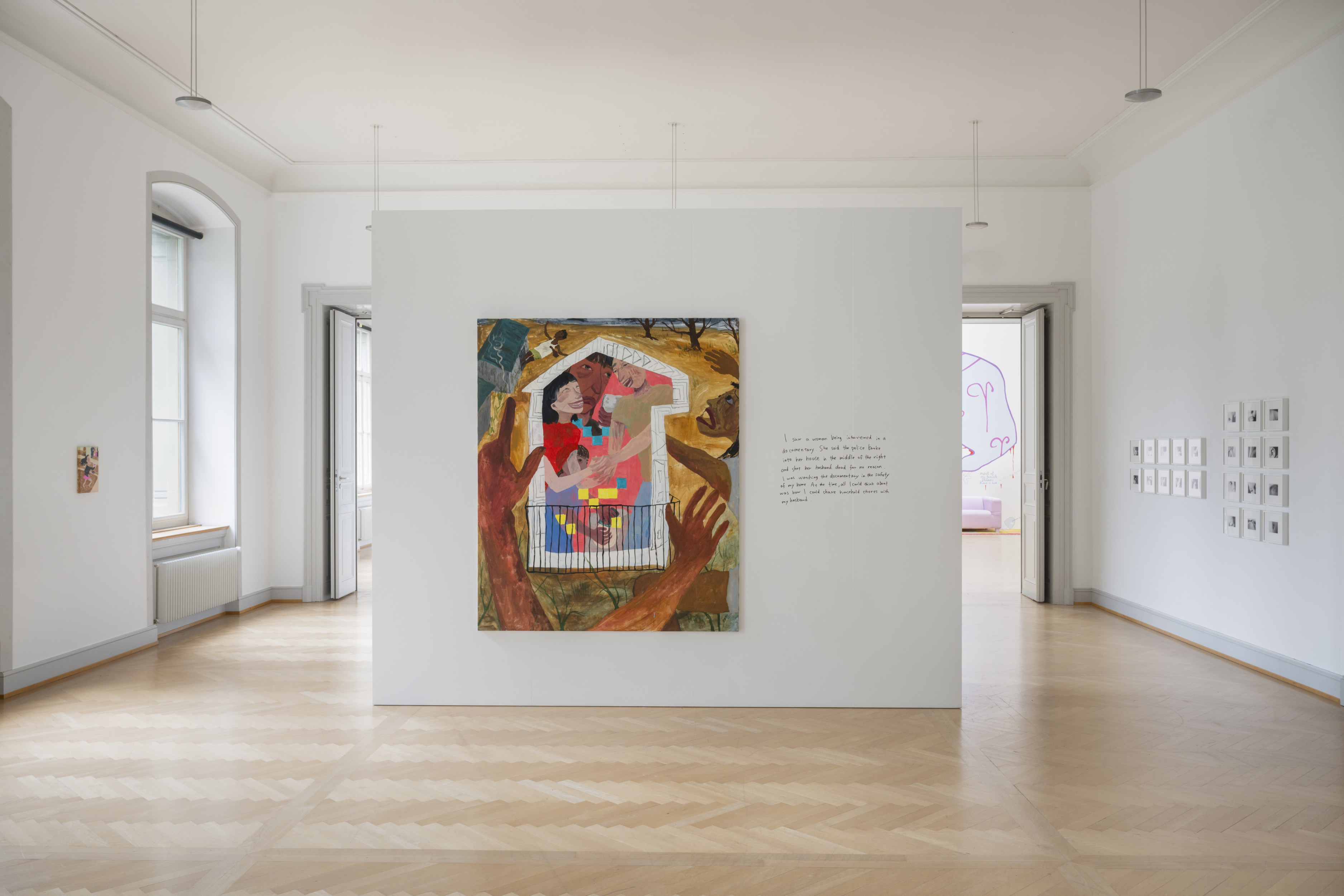
They move toward a man-made wall, which separates the first few works of the show from an installation by Josiane M.H. Pozi titled Pinge (2019–2024). The film is shown on two different TV screens with a single bench in the middle, suspending the viewer between its two narratives, shot in 2019 and 2024 respectively. They sit on the bench as the film plays.
M: You must admit that the family as an “institution” is a banal reality. I mean, it directly reflects what I imagine when it comes to questions and concepts of parenthood and the cultural norms and expectations that come with this. The heteronormativity and the power of conventional individualism in relation to the family unit positions us immediately as victims: the “family” has always failed us. The romanticism of searching for an oppressor is handed to us so easily. It seems almost like the chicken-and-egg problem: which came first; the experience of family or its conceptualization as an institution?
S: Sure, right the family or the institution, but I thin…
M: There is a certain horror we seem to grapple with when we face what binds us to our family. Being a child seems punishment enough — the constant mirroring and inheriting of language, love, traditions and religion. When you find yourself old enough to speak up, your tongue can only reach for similes — like “family as institution” — because you need to win against them, to shift the power dynamics, to acknowledge the violence of it all.
S: Rig…
M: Family-as-institution slogans create such mundane categories, like the “nuclear family” or “chosen family”, terms I just can’t seem to empathise with. Look at Pozi’s words asking her dad, “Daddy, do you love me? Do you actually love me?” again and again, waiting for salvation… You feel the necessity of the work when you watch the video, which weaves itself into a narrative through music, dance and conversations. What makes the work so appealing is the fact that we find ourselves in the position of the (un)dutiful daughter, with the eroticism of familial pain lurking in our skin. Like every daughter, we are made of flesh and bone. But Pozi is here to break the normative patterns of daughterhood — to be able to love your parents while they don’t even have that language themselves, to become their flesh, their tongue.
They walk in a certain rhythm through the second room. Unsurprisingly, M has now taken the lead, which contains, first, a video work by Sekyun Ju titled Dinner, displayed on a small screen. The work focuses on a strict shot of a family dinner table, turning the common space into an observational site focused on customs and traditions, showing how the social conduct of morals, expectations and desires is passed on generationally. On the wall, we are faced with the photomontage collages of Lebohang Kganye, in which the artist has superimposed herself into old photos of her mother in a haunting reflection of grief; Madeleine Kemény-Szemere’s intimate drawings of her husband; Shuvinai Ashoona’s paintings rendered in a colorful palette describing different familia rituals of contemporary Inuit life; and Rhea Dillon’s sculptural work Sole Responsibility: Aged 12, but above IX, a crystal piece on the wall shaped like the sole of a foot.
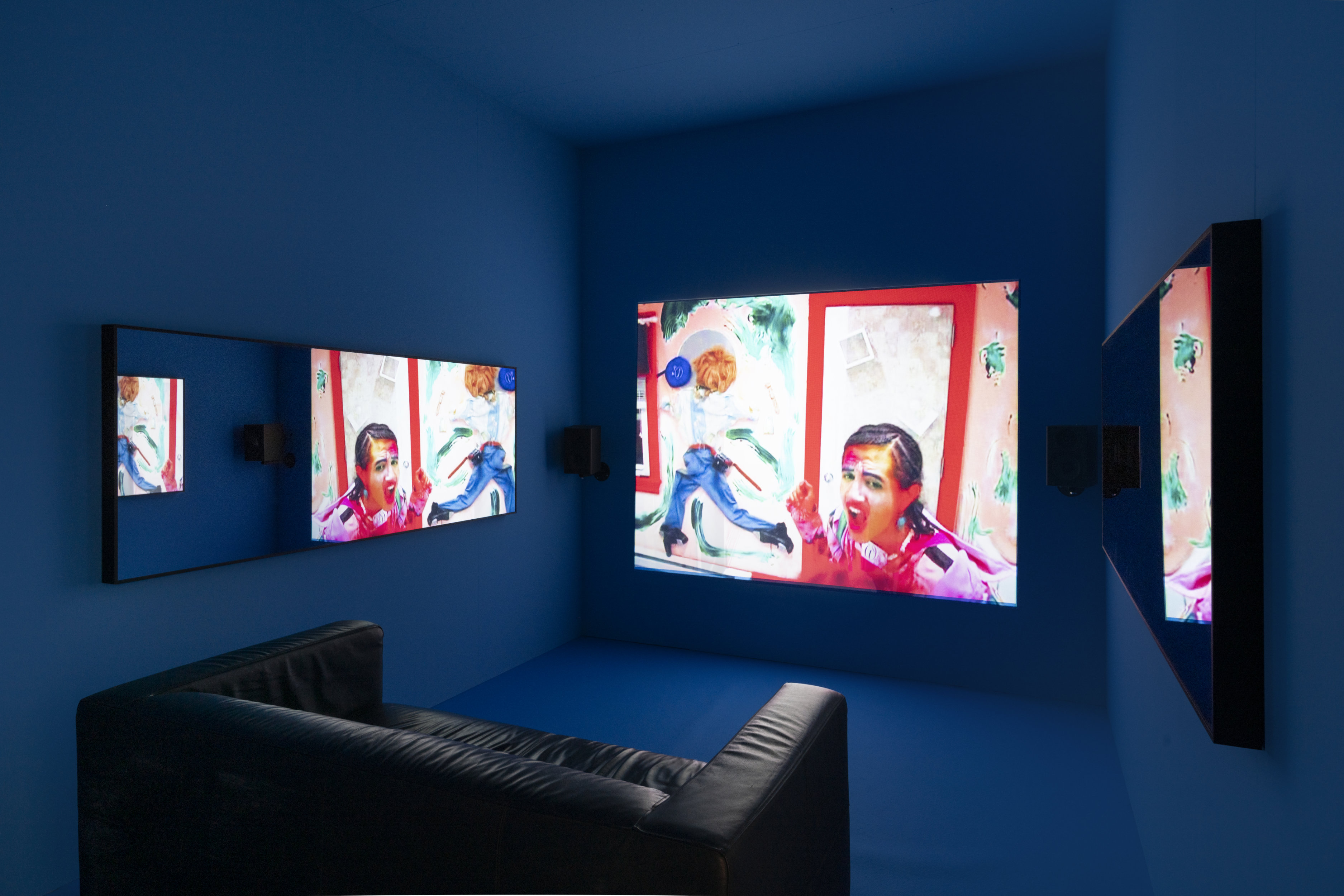
M: It is easy to blame the mother for familial dysfunction, because the “feminine” carries the burden of parenthood heavier in a patriarchal society. In the end, though, “mother” is domesticated along with the child, left alone to be the carrier of the child’s values and morals. But what exactly is it to be an artist who makes auto-fictional or personal work in the context of “family”? If the child remains the subject of their own work, then aren’t we witnessing a domestication or objectification of the parent as “muse”, or in this case “anti-muse”? In many instances with the works on show, there is an absence of dialogue, the parent refigured as ghost. A ghost not only to the visitor but to the artist themself.
S: You kn…
M: What does it mean to have a difficult family, anyway? I mean, sure, no one gets along with their mom perfectly, but what this space and this show allow is that every time I see myself in the victimhood of others, it gives me the freedom I desire to fantasize about becoming the subject, to put my personal matters on show and bare my erotics of familial experiences in institutional spaces. Like a self-fellating hermit.
They move towards the room that contains a painting series by Ben Sakoguchi. In his satirical works, Sakoguchi pokes holes in the hypocrisies of white America and its corresponding “family values” from the vantage point of the legal system. In appropriating the label adorning crates of oranges (which populated his youth), Sakoguchi highlights instances within American history whereby parents and spouses put on trial for the murder of family members falsely accused Black people of committing their crimes as a way to escape punishment. In dialogue with the extremely staged family portraits of Buck Ellison, both artists represent the American Dream filtered through the delusions of the WASP. Significantly, the most prominent work in the gallery belongs to PINK de Thierry, a large three-dimensional photographic cutout, showing the artist’s family “playing house” from a durational performance.
M and S then come to a stop in front of Amalia Ulman’s work, two digitally woven tapestry pieces titled Money and the Family (2016) and What to Do About Money (2015). Ulman’s work equips her voice with humor, achieved through the tonality of the images depicted in the tapestries. Similarly to Sakoguchi, Ulman appropriates a template set by the US government, though this time one issued by the Health Department in the 1990s to prevent the spread of HIV. Ulman makes simple incisions into this history by replacing the word “AIDS” with “Money” and “Poverty”, in turn prompting us to question the economic commodification of family life in relation to who exactly has access to become a family.
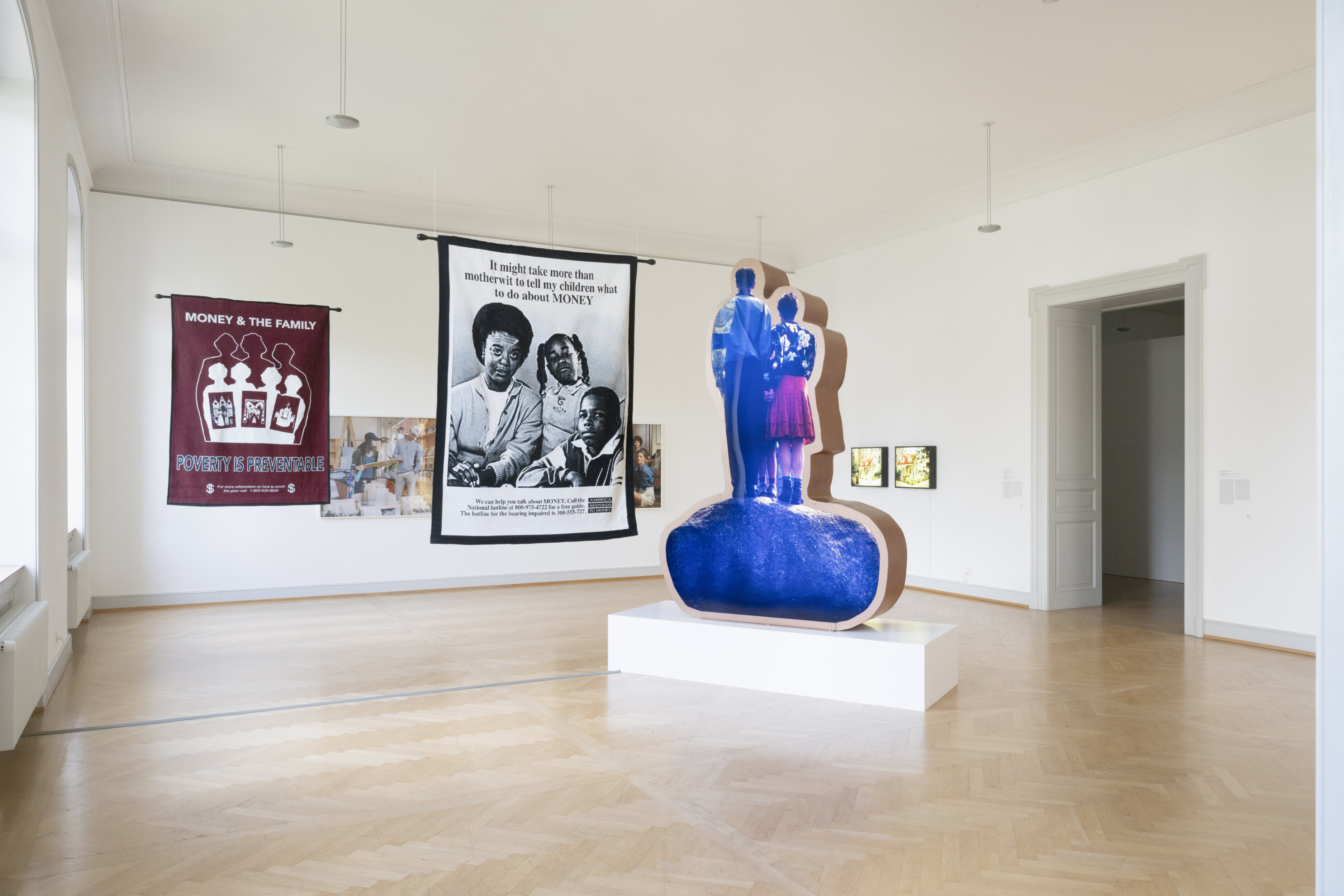
M: These artists seem aware of the cruelties their work can commit. There is a certain edge to putting the works in artistic spaces only with the subject’s language lurking, and, of course, the violence is even sharper because not only is it the artist speaking, but the curator, the assistant curator, the director and many other made-up titles join, like a gang, to provide a new offering: dismembering the mother/father over and over again. An eerie discomfort will always be present in the curation of the show. Then, I find myself asking: What does it mean to curate an exhibition with this eeriness in mind and how far can one take this premise when they occupy both sides of the equation, when they are both child and parent?
S: Hmmm.
They continue walking before tucking into a dark curtained-off space containing a work by Terre Thaemlitz. M’s pretentious monologue goes on, his hand gestures get stronger as the loud soundtrack of Gillian Wearing’s Sacha and Mum (1996) bleeds in from the gallery outside. S hears a daughter’s scream constantly, with no break. He feels suffocated in the space and gets more easily distracted, so he takes M’s hand and leads him deeper into Thaemlitz’s Deproduction (2017).
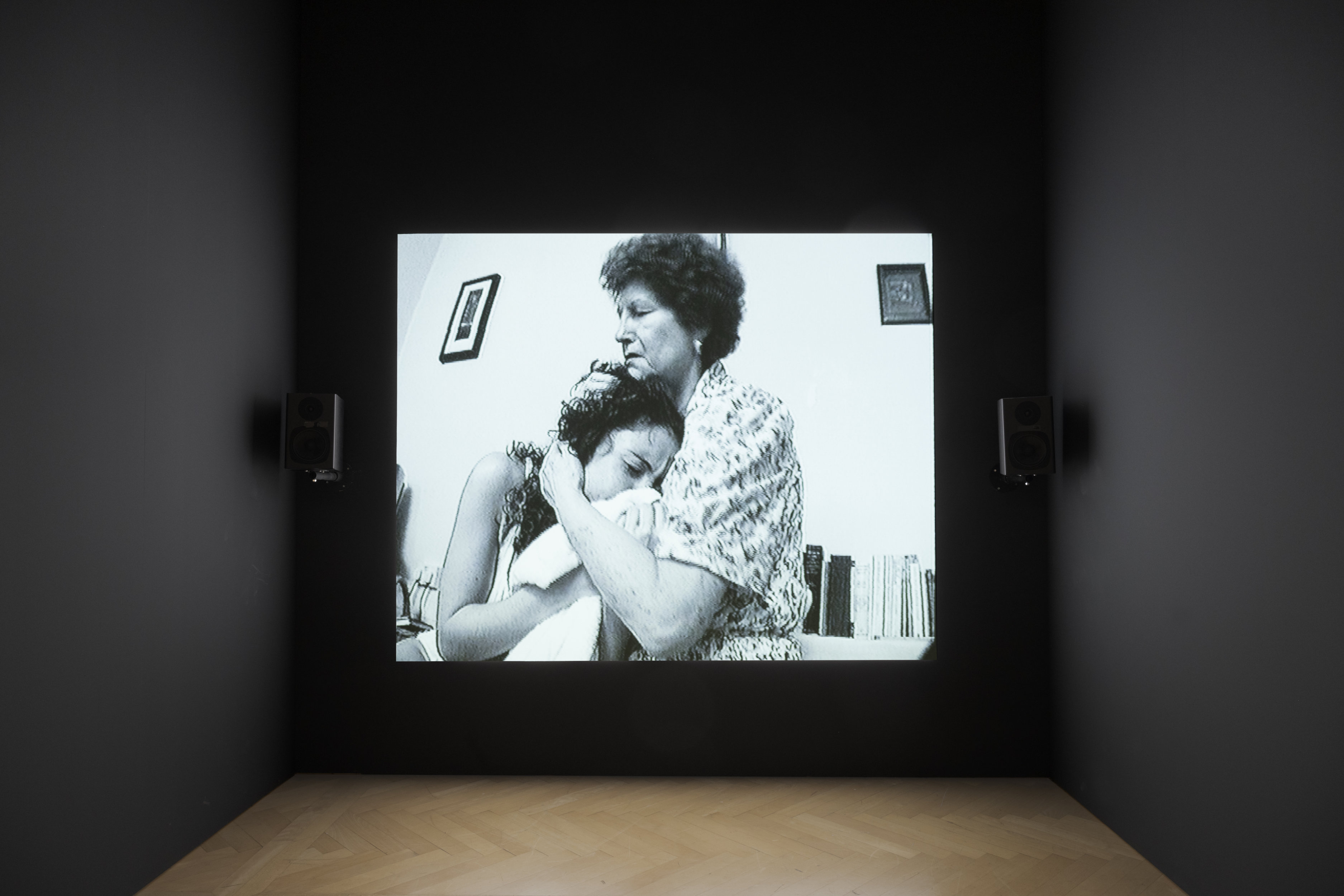
M: Look at this work. It’s a one-channel video installation. We’re surrounded by black curtains which set the viewer in close relation to its haunting stories of families being destroyed by their own politics, traditions and customs. While the oppressed and the oppressor are the family itself, the loneliness of closeted queerness, cheating, physical abuse, rape and incestual desires manifest as a violent escape. The family is in a constant fight with itself, suffocating inside the rules that it has created with the help of the state. Capital is the villain in every narrative we see, but that was expected! Yet sometimes there are moments of awakening. Do you remember the Vaginal Davis drawings in the last room that compartmentalize the family into a self-proclaimed sainthood of femaleness? Heroes and forebears gaze towards us, proud in full color, claiming their space loudly. Or the vengeance in the Gillian Wearing installation we saw, where the violently mirrored relationship between mother and daughter takes up theatrical space, with the mother’s physical abuse being played on loop with no breaks, putting us on the side of the oppressed, telling us that “you have to endure what I endured”. Or, I don’t know, think again about the cheesy concepts like chosen family. I mean, if the family is already the problem itself why do we need to create an alternative one? Why can’t friends, colleagues and lovers be enough? I mean, isn’t that what we felt with Ryan Trecartin’s work—a total disfiguration of family? How the ugliness of it, with its gore and distaste, can be what we need as individuals.
S: Yeah! I als…
M is already moving towards the next room while S is speaking, jetting past Kyoko Idetsu’s painting To Mexico (2022), Louise Bourgeois’s Hours of the Day (2006) and Katja Mater’s Time is an Arrow, Error (2020). Regarding the latter two, both works sit between photograph, print and sketch, both replicating and disrupting time. M and S finally settle in front of Ghislaine Leung’s Hours (2022). Here, after linearity has been disrupted, there is a sense of conclusion, one not only present in Leung’s work — in which the mother’s art practice is determined by a timetable set by the child and through which the child is an involuntary participant in the work itself — but also in the patriarchal systems the art world is also subject to, and the corresponding economic and material realities they produce. Off the back of this, time passes rather unpleasantly with Leung’s work, a remembrance of (im)possibilities.
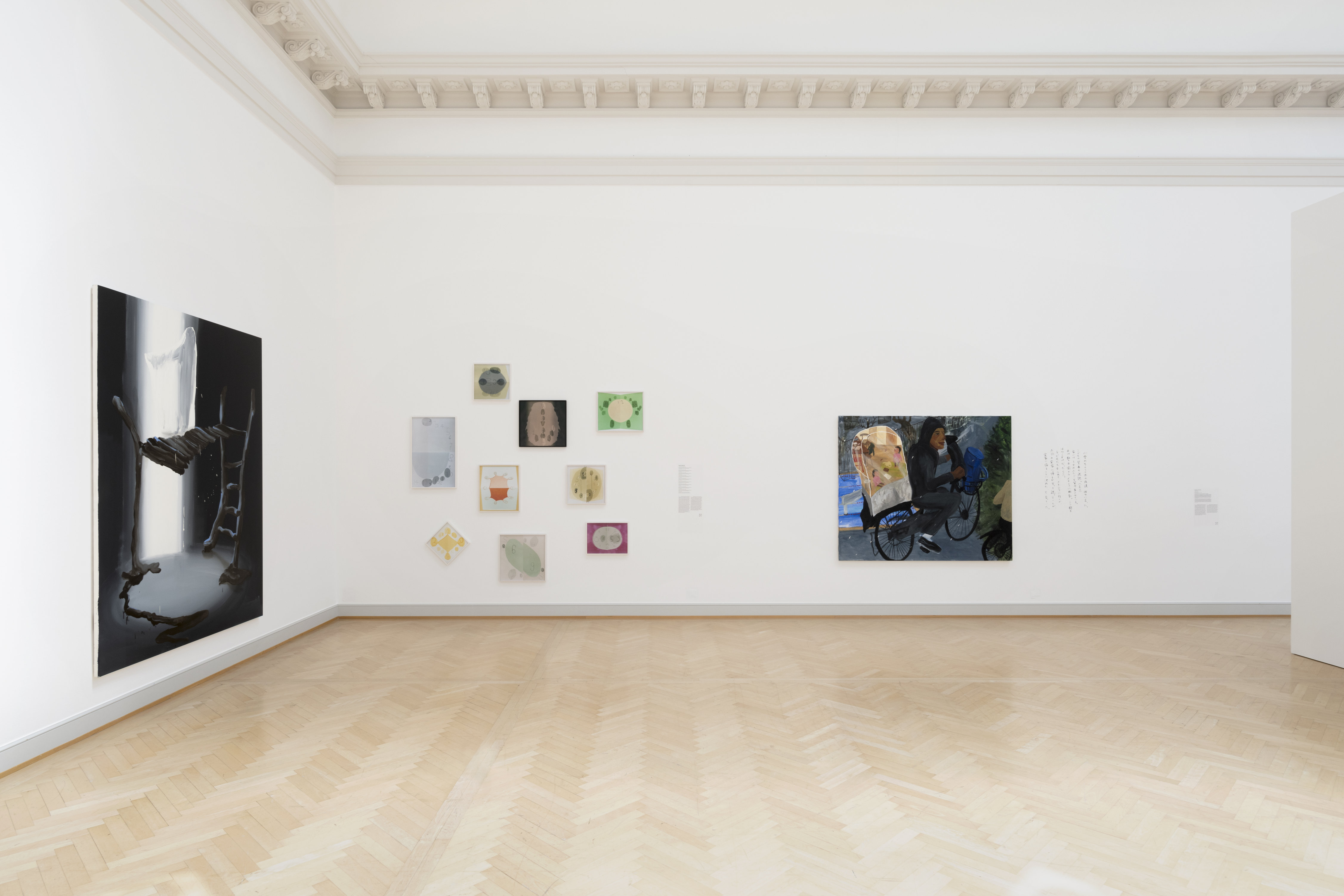
S: What abou…
M: A lot of the works in the exhibition position the artist as the child, but what stands out to me the most are the ones that consider the parent as artist. In these works, the artist is not only the perpetrator, but also the victim of a restrictive system; one that demands their time and focus while also seeming to abstract the child. In the case of Leung, what makes the work so unnerving is exactly its abstraction: there are no screams of frustration, there is no anger, no agony. Instead, it is a methodical and precise installation: Leung rejects martyrdom when it comes to motherhood.
S: But…
M: Then I find myself thinking that the way the hours have been structured in such a precise abstraction is not only a rejection of martyrdom but also a protection mechanism, a way to lure the visitor into the image of Leung as a subject. The narrative is Leung’s — her labor, her child, her self-preserved motherhood — and she is the author of it. Yet then the question becomes: What’s the child’s position in this violence that has been inflicted on their mother by systems that work against her very womanhood? And, given their involuntary participation, how might both mother and child have agency at once? The search for an escape from the restrictions and oppressions of family will always be an ambiguous one as we desire new systems of familial values constantly. Family, as it deems itself in a sacred place, is nothing but a choice that is always bound to repeat itself, but within that choice, what this exhibition importantly asks is who is deserving of empathy within these current configurations…
S: And who is actually afforded it socially!
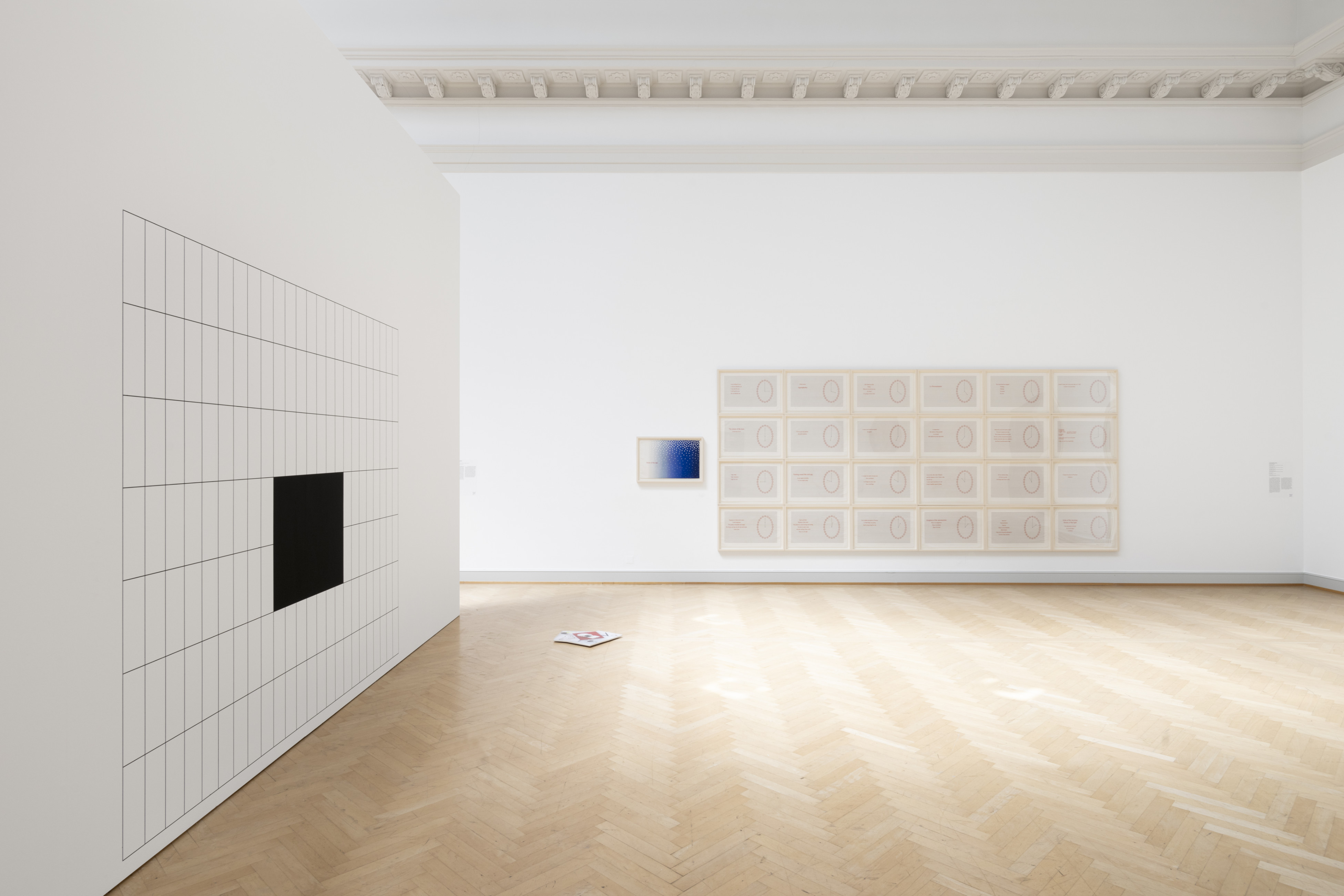
Suddenly, the sound of a baby’s cry floods the gallery and, shocked back to reality, S realizes he has no clue what time it is. It seems he forgot to pay attention to the natural light in the space. The pair turn their attention towards the baby, its cries going on and on. M huffs with frustration while S notices the mother getting more visibly uncomfortable as she tries her best to shush the baby up. As she bobs up and down, lightly patting the back of her baby, he finds himself wondering which of the two he would least like to be: the mother or the child?
- Georges Bataille, My Mother, Madame Edwarda and The Dead Man. (London: Marion Boyars), 1989, 80.